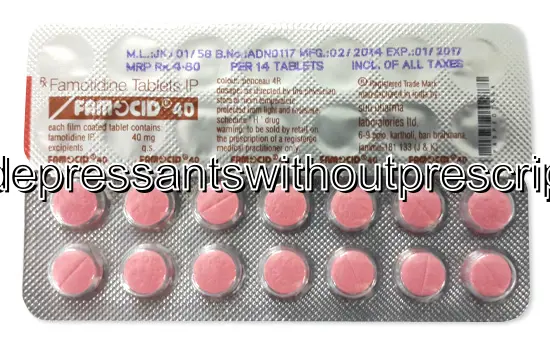| Package | Dosage | Price | Price per Dose | |
|---|---|---|---|---|
| Dosage: 20mg | ||||
| 336 pill | 20mg | NZD300.41 | NZD0.89 | |
| 224 pill | 20mg | NZD254.39 | NZD1.14 | |
| 168 pill | 20mg | NZD227.33 | NZD1.35 | |
| 112 pill | 20mg | NZD184.02 | NZD1.65 | |
| 84 pill | 20mg | NZD148.84 | NZD1.76 | |
| 56 pill | 20mg | NZD108.24 | NZD1.92 | |
| 28 pill | 20mg | NZD62.22 | NZD2.19 | |
| Dosage: 40mg | ||||
| 336 pill | 40mg | NZD346.42 | NZD1.03 | |
| 224 pill | 40mg | NZD273.34 | NZD1.22 | |
| 168 pill | 40mg | NZD227.33 | NZD1.35 | |
| 112 pill | 40mg | NZD175.90 | NZD1.57 | |
| 84 pill | 40mg | NZD135.30 | NZD1.62 | |
| 56 pill | 40mg | NZD105.53 | NZD1.87 | |
| 28 pill | 40mg | NZD56.81 | NZD2.00 | |

Famotidine Description
Overview of Famotidine
Famotidine is a medication commonly used to treat conditions related to excess stomach acid production. It belongs to the class of drugs known as H2 receptor antagonists, which work by blocking histamine receptors in the stomach lining. This action reduces the amount of acid produced, helping to alleviate symptoms and promote healing of related conditions. Famotidine is often prescribed for conditions such as gastroesophageal reflux disease (GERD), ulcers, and Zollinger-Ellison syndrome. Its effectiveness and relatively favorable side effect profile have made it a popular choice among both healthcare providers and patients seeking relief from acid-related issues.
Mechanism of Action and Effectiveness
Famotidine exerts its effects by selectively inhibiting the histamine H2 receptors on parietal cells in the stomach. This inhibition decreases the production of gastric acid, leading to a less acidic environment in the stomach. As a result, symptoms such as heartburn, acid indigestion, and discomfort caused by ulcers often improve significantly. Many users report rapid relief following administration, with some noticing an improvement within a few hours. The medication is generally effective for both short-term symptomatic relief and long-term management of chronic acid-related conditions. Its potency is comparable to, or sometimes exceeds, other H2 blockers, making it a reliable medication in its class.
Usage and Dosage
Famotidine is available in various forms, including tablets, oral suspensions, and injectable forms. The dosage depends on the specific condition being treated, as well as the patient's age and overall health. Typically, for adults, the recommended dose for treating GERD or ulcers ranges from 20 to 40 mg once or twice daily. It’s important for individuals to follow the prescribing instructions carefully. For optimal results, medications should be taken before meals, although some conditions may require a different schedule. Patients with kidney impairment may need dose adjustments, so consulting a healthcare professional before starting treatment is advisable.
Potential Benefits and Advantages
Many patients find famotidine to be an effective and well-tolerated medication. Its benefits include quick symptom relief, ease of use, and a generally mild side effect profile. Because it is over-the-counter in many regions, it provides accessible relief without the need for a prescription, making it convenient for managing occasional acid reflux or heartburn. Additionally, famotidine has a relatively low likelihood of drug interactions compared to some other medications, which can be a significant advantage for patients on multiple treatments. Its ability to promote healing of ulcers and reduce gastric acidity can also prevent complications such as bleeding or tissue damage in chronic cases.
Possible Side Effects and Precautions
While famotidine is considered safe for most users, some may experience side effects. Common reactions include headache, dizziness, constipation, or diarrhea. Serious side effects are rare but can include allergic reactions, such as rash, itching, swelling, or breathing difficulties. Long-term use may be associated with certain risks, like vitamin B12 deficiency, due to decreased stomach acid necessary for absorption. Patients with kidney issues should consult a healthcare provider for proper dosing. Pregnant and breastfeeding women should also discuss potential risks with their doctor before use. It is important to disclose all medications and health conditions to ensure safe administration.
Conclusion
Famotidine remains a widely used and trusted medication for managing stomach acid-related conditions. Its effectiveness in suppressing acid production and promoting healing makes it a valuable option for many individuals. When used correctly and under medical supervision, famotidine offers a convenient and generally safe approach to controlling symptoms such as heartburn and ulcers. As always, users should be aware of potential side effects and consult healthcare providers to tailor the treatment to their specific needs. Proper adherence to dosages and guidance can help maximize benefits while minimizing risks.
